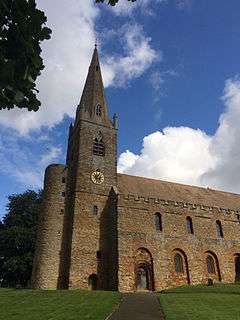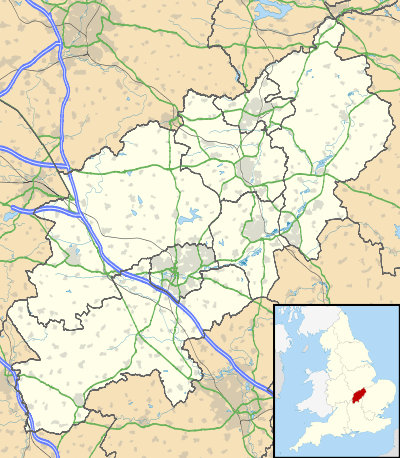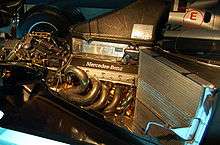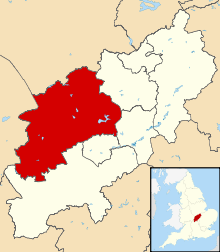Brixworth
Brixworth is a large village and civil parish in the Daventry district of Northamptonshire, England. The 2001 census recorded a parish population of 5,162,[1] increasing to 5,228 at the 2011 census.[2] The village's All Saints' Church is of Anglo-Saxon origin.
| Brixworth | |
|---|---|
 All Saints' Church, Brixworth | |
 Brixworth Location within Northamptonshire | |
| Population | 5,162 (2001 census)[1] 5,228 (2011 census) |
| OS grid reference | SP7470 |
| Civil parish |
|
| District |
|
| Shire county | |
| Region | |
| Country | England |
| Sovereign state | United Kingdom |
| Post town | Northampton |
| Postcode district | NN6 |
| Dialling code | 01604 |
| Police | Northamptonshire |
| Fire | Northamptonshire |
| Ambulance | East Midlands |
| UK Parliament | |
| Website | Brixworth Online |
Location
The village is about 5 miles (8 km) north of Northampton next to the A508 road, now by-passed, and about 8 miles (13 km) south of Market Harborough. About 3 miles (5 km) north of the village is a junction with the A14 road that runs between the M1 and M6 motorway interchange at Catthorpe east to Cambridge and the east coast port of Felixstowe.
The village is popular with commuters to Leicester, Peterborough, Birmingham and London. The nearest railway stations for London are at Northampton, for EUS (Euston), and Kettering for STP (St Pancras) and for Leicester LEI (London Rd) at Market Harborough.
History

A lengthy article about the history of the parish appears in the Victoria County History for Northamptonshire, volume 4, which was published in 1937. Its text can be consulted at British History Online.[3]
The main road from Northampton to Market Harborough passed through the village, where a number of inns served the needs of travellers for refreshment, lodging and a change of horses. The buildings of two present-day pubs in the village date back to the era of horse-drawn transport:
In 1819 Sir Charles Knightley purchased land between Spratton Road and Kennel Terrace, where the Pytchley Hunt then erected kennels, providing a fresh source of local employment at a time of agricultural depression. The Hunt remained in the village until 1966, after which the site was developed for housing.
The church
All Saints' church is one of the oldest, largest and most complete Anglo-Saxon churches in the country. It was founded circa 680 AD and has been called as "The finest Romanesque church north of the Alps".[6]
Chartism
In June 1839, Brixworth was the scene of notable public meeting addressed by the Chartist Robert George Gammage of Northampton. Before the meeting took place, Gammage and his two companions attended a service in the parish church where the vicar Charles Frederic Watkins rebuked them and threatened the three with arrest if the meeting proceeded. Despite this, Gammage recalled that attendance at the roadside assembly later that day amounted to several hundreds and Watkins' efforts to persuade the constable to arrest those who addressed it were unsuccessful.[7]
Poor Law Union
Brixworth Poor Law Union was established in 1835 and a workhouse erected on the south side of Spratton Road soon afterwards. Only the entrance block, including some later side extensions to it, remains; these premises are now used for business purposes.[8] The activities of the Brixworth Poor Law Union attracted controversy, particularly in the latter part of the 19th century, because of its reluctance to provide relief to poor people unless they agreed to enter the Workhouse. Brixworth is the focus of a substantial work on the political, social and personal implications of welfare policies during the period.[9] The Workhouse was closed in 1935.
The railway
The Northampton and Market Harborough railway through the parish was opened in 1859, passing 0.5 miles (800 m) west of the village. British Railways closed Brixworth railway station to passenger traffic in 1960 and closed the line to freight traffic in 1981. The trackbed of the former railway was reopened in 1993 as the Brampton Valley Way.
Iron ore quarrying
At various times iron ore quarrying has been carried out on the north, east and south sides of the village. The ore was taken in various ways to the railway for transport to ironworks. The first quarry can still be seen west of the church at a place called Stonepit Close. It is now allotments. Quarrying began in 1863 and finished about 1874. It is not clear if the ore was taken away by tramway or by horse and road wagon to the station. In about 1873 another quarry was opened nearby, to the north of the church. This was connected by 4 ft (1,219 mm) gauge tramway to sidings at the station. When this was worked out the same tramway served later quarries further east to the north and south of Scaldwell Road, finishing in 1936 south of Scaldwell Road and in 1947 further north. The later quarries in this system were to the east of the A508.
Another quarry began in 1873 to the south of the village connected with the railway by 4 ft (1,219 mm) gauge tramway. This was firstly to the west of the main road in the area to the south of Foxhill Crescent and later to the east of the main road in the vicinity of what is now Ashway. Quarrying finished here in about 1912.
A new pit was begun in 1939, operating until 1949. This was operated by the Staveley Coal and Iron Company and was connected to their quarrying operation at Scaldwell by an extension of their 3 ft (914 mm) gauge tramway. The ore was transported from Scaldwell to sidings near Hanging Houghton via an aerial ropeway. The aerial ropeway was replaced in 1954 by a standard gauge branch line.[10]
Another quarry began operation in 1880 west of Station Road, opposite Stonepit Close. It had its own tramway to the sidings at Brixworth Station and ceased operation in 1896.
The 4 ft (1,219 mm) gauge tramways were worked by horse at first but the first steam locomotive was in use by 1879. Quarrying was done by hand at first. The first steam quarrying machine was in use by 1917, and the first diesel machine in 1935[10]. Close to the south and east of the village most of the quarried area has had housing and an industrial estate built on it. In the industrial estate the street names Ironstone Way, Quarry Road, Ferro Fields and Staveley Way commemorate the quarries. Apart from Stonepit Close the visible remains of the quarrying are in the form of ground levels being below the roads and surrounding fields. The industrial estate and part of the churchyard are lower than the original landscape, due to the quarrying activity.
Village development
From the 1960s onwards, a large amount of new housing has been built at Brixworth, mainly on fields to the south of the original village. A by-pass on the east side has diverted traffic travelling between Northampton and Market Harborough away from the built-up area. Another major change has been the creation of Pitsford Water (a reservoir) and Brixworth Country Park, which are a short distance from the village.[11]
Notable buildings
The Historic England website contains details of a total of 17 listed buildings in the parish of Brixworth, all of which are Grade II apart from All Saints' Church, which is Grade I.[12] They include:
- All Saints' Church, Church Street[13]
- Brixworth War Memorial, All Saints' Churchyard[14]
- Coach and Horses Inn, Harborough Road[15]
- Cross, Church Street[16]
- Home Farmhouse, Church Street[17]
- Mint Cottage, Church Street[18]
- Steps Cottage, Silver Street[19]
- The Firs, Saneco Lane[20]
- George Inn, Northampton Road[21]
- The Granary, Church Street[22]
- The Grange, Kennel Terrace[23]
- The Lodge, Northampton Road[24]
- Manor House, Harborough Road[25]
- Old Vicarage, Church Street[26]
- Pound House, Northampton Road[27]
Brixworth Hall
_p3.124_-_Brixworth_Hall%2C_Northamptonshire.jpg)
Brixworth Hall was near the church, surrounded by a park and close to the centre of the historic settlement of Brixworth. The hall was built in the Tudor period by the Saunders family who were part owners of the manor of Brixworth from 1532.[28] The house was owned by four generations of the Saunders family until the early 18th century.[29] It was extended in the 18th century, incorporating parts of the original building.[29] The house was offered for sale by auction in 1801 at which time it was described as being a spacious stone mansion with coach house, stabling, gardens, canals and fish-ponds.[30] The hall was demolished in 1954.[31]
Churches
The churches that currently worship at Brixworth are:
- All Saints' Parish Church
- Brixworth Christian Fellowship
A Wesleyan Methodist (later Methodist) chapel was opened in Church Street in 1811 and enlarged in 1860. The chapel closed in the 1970s and the building is now in residential use.[32]
School
The status of the primary school at Brixworth is Church of England Voluntary Controlled. Details of a series of reports on the school can be found in the relevant section of the Ofsted website.[33] 450 pupils were on the roll at the time of the inspection in September 2011.
Clubs and amenities
Brixworth Juniors Football Club is a football club that encourages children of all ages to be active and play sport. It has produced successful footballers, including AFC Rushden & Diamonds' Liam Dolman and Derby County's Jack Marriot. The adults' team, Brixworth All Saints, are in Division One of the Northamptonshire Football Combination, which is at level 8 of the National League System. It plays its home games on the village's St David's Recreation Ground.
Brixworth Cricket Club plays on the ground at Haywards Barn, which was opened in 2008, as well as on St David's playing field for third team and junior games. The 1st team play in the premier division of the Northants Cricket League and the 2nd and 3rd team play in Divisions 5 and 13. They run 4 junior teams between ages 9 and 17 who play on both grounds.
The Drama Society stages 2–3 productions annually – including a pantomime.
The village is home to an award-winning historical re-enactment society, Sir William Harrington's Companye, who recreate life as it would have been for the 15th-century inhabitants of Brixworth.
There is a free village newspaper, the Brixworth Bulletin.
Brampton Valley Way passes 0.7 miles (1.1 km) west of the village, Pitsford Reservoir is about 1 mile (2 km) to the southeast and the Northampton & Lamport Railway is 2.7 miles (4 km) to the south at Pitsford and Brampton railway station.
Wind farm
In 2008, the Mercedes-Benz HighPerformanceEngines (HTP) premises in Brixworth planned to build two 127 m (417 ft) high wind turbines. Lancaster-based Wind Direct has submitted a planning application to Daventry District Council to install the two turbines and Mercedes-Benz HTP plans to use 92 per cent of the electricity generated, with the rest being exported to the National Grid. The plans[34][35] are controversial with opposition from some, but not all local residents.
Notes
- "Area selected: Daventry (Non-Metropolitan District)". Neighbourhood Statistics: Full Dataset View. Office for National Statistics. Retrieved 19 April 2011.br
- "Civil Parish population 2011". Neighbourhood Statistics. Office for National Statistics. Retrieved 29 June 2016.
- "Brixworth". Retrieved 7 February 2013.
- "The George Inn Brixworth". Retrieved 7 February 2013.
- "The Coach and Horses Brixworth". Retrieved 7 February 2013.
- Clapham, 1930, page 33, cited in Blair, 1977, page 152
- Robert George Gammage. "Becoming a Chartist speaker, and first leaving Northampton in 1840". A Vision of Britain Through Time. Retrieved 16 September 2015.
- "Brixworth Poor Law Union". Retrieved 13 February 2015.
- Hurren, Elizabeth T (2007). Protesting About Pauperism: Poverty, Politics and Poor Relief in Late-Victorian England, 1870-1900. Woodbridge: The Boydell Press. ISBN 978-0-86193-292-4.
- Tonks, Eric (April 1989). The Ironstone Quarries of the Midlands Part 3: The Northampton Area. Cheltenham: Runpast Publishing. p. 167-183. ISBN 1-870-754-034.
- "Brixworth Country Park". Archived from the original on 16 February 2013. Retrieved 7 February 2013.
- "Historic England – The List". Retrieved 5 October 2015.
- "Historic England – Church of St All Saints, Brixworth". Retrieved 6 October 2015.
- "Historic England – Brixworth War Memorial". Retrieved 6 October 2015.
- "Historic England – Coach & Horses". Retrieved 6 October 2015.
- "Historic England – The Cross, Brixworth". Retrieved 6 October 2015.
- "Historic England – Home Farmhouse". Retrieved 6 October 2015.
- "Historic England – Mint Cottage". Retrieved 6 October 2015.
- "Historic England – Steps Cottage". Retrieved 6 October 2015.
- "Historic England – The Firs". Retrieved 6 October 2015.
- "Historic England – The George Inn". Retrieved 6 October 2015.
- "Historic England – The Granary". Retrieved 6 October 2015.
- "Historic England – The Grange". Retrieved 6 October 2015.
- "Historic England – The Lodge". Retrieved 6 October 2015.
- "Historic England – The Manor House". Retrieved 6 October 2015.
- "Historic England – The Old Vicarage". Retrieved 6 October 2015.
- "Historic England – The Pound House". Retrieved 6 October 2015.
- Towns and Villages around Northampton
- Victoria County History
- Sale particulars
- England's Lost Heritage
- Brixworth History Society (1993). Brixworth Now & Then. Brixworth: Brixworth History Society. p. 3.
- "Brixworth Primary School". Ofsted. Retrieved 20 September 2015.
- "Northampton Chronicle & Echo: Fight to stop wind turbines, 3 November 2008". Retrieved 3 November 2008.
- "Plan for wind turbines temporarily withdrawn, 14 November 2008". Retrieved 14 November 2008.
References
- Blair, Peter Hunter (1977) [1956]. An Introduction to Anglo-Saxon England (Second ed.). Cambridge & London: Cambridge University Press. pp. 146, 151–152. ISBN 0-521-29219-0.
- Brixworth History Society (1999). A Pictorial History of Brixworth. Brixworth: Brixworth History Society. ISBN 0-9536010-0-5.
- Brixworth History Society (2012). Another History of Brixworth in words and pictures. Brixworth: Brixworth History Society. ISBN 9780953601035.
- Clapham, A.W. (1930). English Romanesque Architecture: Volume I: Before the Conquest. Oxford: Clarendon Press. p. 30.
- Pevsner, Nikolaus; Cherry, Bridget (1973) [1961]. Northamptonshire. The Buildings of England. Harmondsworth: Penguin Books. pp. 124–127. ISBN 0-14-071022-1.
- Salzman, L.F., ed. (1937). A History of the County of Northampton, Volume 4. Victoria County History. pp. 150–157.
External links
| Wikimedia Commons has media related to Brixworth. |
